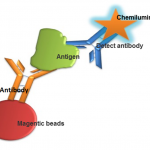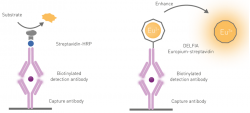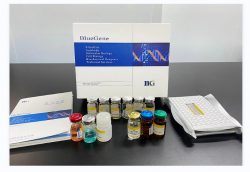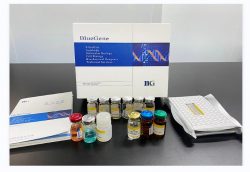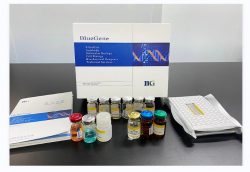Difference Between ELISPOT and ELISA
Difference Between ELISPOT and ELISA
October 18, 2022 Posted by Axispharm
With the wide application of ELISA technology in the medical and biological fields, new breakthroughs have been made in the detection of various cytokines and antibodies in vitro. When studying the mechanism of immune response, enzyme-linked immunosorbent assay (ELISA) was used to detect free cytokines (CK) or antibodies in body fluids. Metabolized or combined with target organs, but cannot accurately reflect the level of antibodies and CK in vivo. In the 1980s, based on the basic principle of ELISA technology, researchers established a solid-phase enzyme-linked immunospot technique (ELISPOT) for detecting specific antibody-secreting cells and CK-secreting cells in vitro.
Main difference between ELISPOT and ELISA:
The ELISPOT method is derived from ELISA and breaks through the traditional ELISA method. It is an extension and new development of quantitative ELISA technology. Both detect cytokines or other soluble proteins produced by cells, and their biggest differences are:
1. ELISA measures the absorbance on a microplate reader through a color reaction, and compares it with the standard curve to obtain a quantitative total amount of soluble protein.
2. ELISPOT shows clearly distinguishable spots on the corresponding positions where the soluble protein is secreted by cells through the color reaction. The spots can be manually counted directly under the microscope or counted by the ELISPOT analysis system. One spot represents one spot. Active cells to calculate the frequency of cells secreting the protein or cytokine. (Some studies measure not only the amount of cytokine produced, but also the frequency of cells secreting the cytokine)
3. Because it is a single-cell level detection, ELISPOT is more sensitive than ELISA and limiting dilution methods, and can detect 1 cell secreting this protein from 200,000-300,000 cells.
4. The capture antibody is a high-affinity, high-specificity, low-endotoxin monoclonal antibody produced by Swedish high-tech biological company MABTECH, BD, R&D. When researchers activate cells with stimulators, they will not affect the secretion of cytokines by activated cells.
Detection principle
Cells are stimulated to locally produce cytokines, which are captured by specific monoclonal antibodies. After cell dissociation, the captured cytokines bind to biotin-labeled secondary antibodies, which in turn bind to alkaline phosphatase-labeled avidin. After incubation with BCIP/NBT substrate, “purple” spots appeared on the PVDF plate, indicating that the cells produced cytokines, and the results were obtained after the spots were analyzed by the ELISPOT enzyme-linked spot analysis system.
Application field
Prediction of rejection in transplantation, vaccine development, Th1/Th2 analysis, autoimmune disease research, tumor research, allergic disease research, infectious disease research, epitope mapping analysis, screening of compounds and drug immunological responses, etc.
https://axispharm.com/difference-between-elispot-and-elisa/






